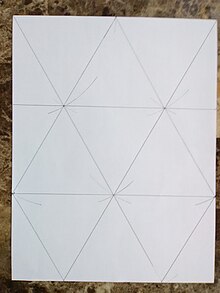
ISO 216 is an international standard for paper sizes, used around the world except in North America and parts of Latin America. The standard defines the "A", "B" and "C" series of paper sizes, which includes the A4, the most commonly available paper size worldwide. Two supplementary standards, ISO 217 and ISO 269, define related paper sizes; the ISO 269 "C" series is commonly listed alongside the A and B sizes.

Paper size standards govern the size of sheets of paper used as writing paper, stationery, cards, and for some printed documents.

An engineering drawing is a type of technical drawing that is used to convey information about an object. A common use is to specify the geometry necessary for the construction of a component and is called a detail drawing. Usually, a number of drawings are necessary to completely specify even a simple component. These drawings are linked together by a "master drawing." This "master drawing" is more commonly known as an assembly drawing. The assembly drawing gives the drawing numbers of the subsequent detailed components, quantities required, construction materials and possibly 3D images that can be used to locate individual items. Although mostly consisting of pictographic representations, abbreviations and symbols are used for brevity and additional textual explanations may also be provided to convey the necessary information.
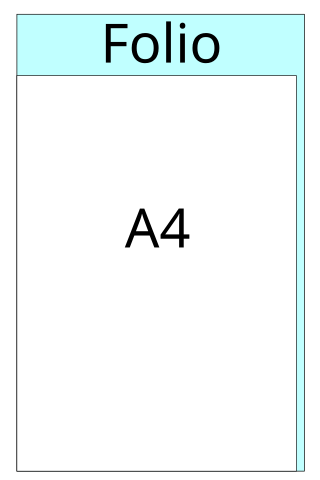
Foolscap folio, commonly contracted to foolscap or cap or folio and in short FC, is paper cut to the size of 8.5 × 13.5 in for printing or to 8 × 13 in for "normal" writing paper (foolscap). This was a traditional paper size used in some parts of Europe, and the British Commonwealth, before the adoption of the international standard A4 paper.

Octavo, a Latin word meaning "in eighth" or "for the eighth time", is a technical term describing the format of a book, which refers to the size of leaves produced from folding a full sheet of paper on which multiple pages of text were printed to form the individual sections of a book. An octavo is a book or pamphlet made up of one or more full sheets on which 16 pages of text were printed, which were then folded three times to produce eight leaves. Each leaf of an octavo book thus represents one eighth the size of the original sheet. Other common book formats are folios and quartos. Octavo is also used as a general description of the size of books that are about 8 to 10 inches tall, and as such does not necessarily indicate the actual printing format of the books, which may even be unknown as is the case for many modern books. These terms are discussed in greater detail in book sizes.

A hole punch, also known as hole puncher, or paper puncher, is an office tool that is used to create holes in sheets of paper, often for the purpose of collecting the sheets in a binder or folder. A hole punch can also refer to similar tools for other materials, such as leather, cloth, or sheets of plastic or metal.
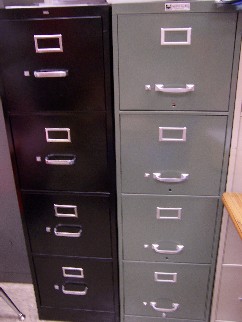
A filing cabinet is a piece of office furniture for storing paper documents in file folders. In the most simple context, it is an enclosure for drawers in which items are stored. The two most common forms of filing cabinets are vertical files and lateral files. A vertical file cabinet has drawers that extend from the short side of the cabinet. A lateral file cabinet has drawers that extend from the long side of the cabinet. These are also called side filers in Great Britain. There are also shelf files which go on shelves. In the United States, file cabinets are usually built to accommodate 8.5 × 11 paper, and in other countries, filing cabinets are often designed to hold other sizes of paper, such as A4 paper.

Ring binders are large folders that contain file folders or hole punched papers. These binders come in various sizes and can accommodate an array of paper sizes. These are held in the binder by circular or D-shaped retainers, onto which the contents are threaded. In North America, the rings themselves come in a variety of sizes, including 0.5, 1, 1.5, and 2 inches, though other sizes are also available. The rings may be secured by lever arch mechanisms or other securing systems, or may be spring-loaded. The binders themselves are typically made from plastic with metal rings. Early designs were patented during the early 1890s to the early 1900s.
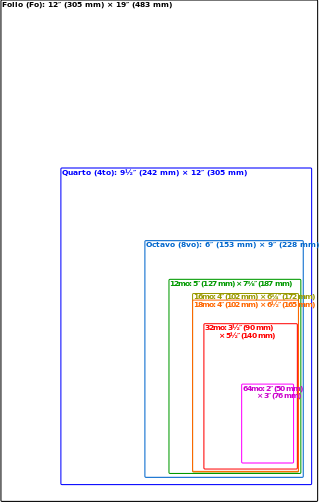
The size of a book is generally measured by the height against the width of a leaf, or sometimes the height and width of its cover. A series of terms is commonly used by libraries and publishers for the general sizes of modern books, ranging from folio, to quarto (smaller) and octavo. Historically, these terms referred to the format of the book, a technical term used by printers and bibliographers to indicate the size of a leaf in terms of the size of the original sheet. For example, a quarto historically was a book printed on sheets of paper folded in half twice, with the first fold at right angles to the second, to produce 4 leaves, each leaf one fourth the size of the original sheet printed – note that a leaf refers to the single piece of paper, whereas a page is one side of a leaf. Because the actual format of many modern books cannot be determined from examination of the books, bibliographers may not use these terms in scholarly descriptions.

An exercise book or composition book is a notebook that is used in schools to copy down schoolwork and notes. A student will usually have different exercise books for each separate lesson or subject.
Grammage and basis weight, in the pulp and paper industry, are the area density of a paper product, that is, its mass per unit of area. Two ways of expressing grammage are commonly used:

Card stock, also called cover stock and pasteboard, is paper that is thicker and more durable than normal writing and printing paper, but thinner and more flexible than other forms of paperboard.
The ISO 217:2013 standard defines the RA and SRA paper formats.
Various measures of paper quantity have been and are in use. Although there are no S.I. units such as quires or bales, there are ISO and DIN standards for the ream. Expressions used here include U.S. Customary Units.

Continuous stationery (UK) or continuous form paper (US) is paper which is designed for use with dot-matrix and line printers with appropriate paper-feed mechanisms. Other names include fan-fold paper, sprocket-feed paper, burst paper, lineflow, tractor-feed paper, and pin-feed paper. It can be single-ply or multi-ply, often described as multipart stationery or forms. Continuous stationery is often used when the final print medium is less critical in terms of the appearance at the edges, and when continuously connected individual sheets are not inconvenient for the application. Individual sheets can be separated at the perforation, and sheets also have edges with punched holes, which also can be removed at the perforation.
Standard photographic print sizes are used in photographic printing. Cut sheets of paper meant for printing photographs are commonly sold in these sizes.
Engineering drawing abbreviations and symbols are used to communicate and detail the characteristics of an engineering drawing. This list includes abbreviations common to the vocabulary of people who work with engineering drawings in the manufacture and inspection of parts and assemblies.
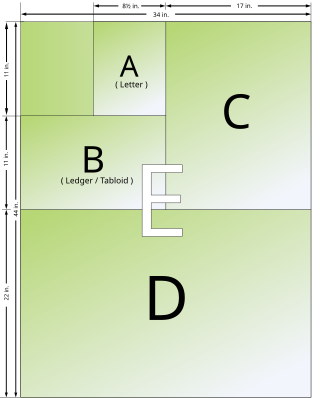
In 1992, the American National Standards Institute adopted ANSI/ASME Y14.1Decimal Inch Drawing Sheet Size and Format, which defined a regular series of paper sizes based upon the de facto standard 8+1⁄2 in × 11 in "letter" size to which it assigned the designation "ANSI A". This series also includes "ledger"/"tabloid" as "ANSI B". This series is somewhat similar to the ISO 216 standard in that cutting a sheet in half would produce two sheets of the next smaller size. Unlike the ISO standard, however, the arbitrary aspect ratio forces this series to have two alternating aspect ratios. ANSI/ASME Y14.1 has been revised or updated in 1995, 2005, 2012 and 2022. It had an accompanying standard, ANSI/ASME Y14.1M, that defined metric drawing paper sizes based upon ISO 216 and ISO 5457. ASME Y14.1 and ASME Y14.1M have now been revised and consolidated into one document, ASME Y14.1-2020, Drawing Sheet Size and Format, published on 18 December 2020.
Despite fire hose and hydrant coupler standardization efforts that are at least 144 years old, there remain significant areas in Canada, the United States, and Mexico that use fire hose and hydrant threads and other couplings that are incompatible with those used by neighboring fire departments. This is notable because the first fire hydrant was invented by Manhattan fire fighter George Smith in 1817, making these devices 200 years old.
ASME Y14.5 is a standard published by the American Society of Mechanical Engineers (ASME) to establish rules, symbols, definitions, requirements, defaults, and recommended practices for stating and interpreting Geometric Dimensions and Tolerances (GD&T). ASME/ANSI issued the first version of this Y-series standard in 1973.
